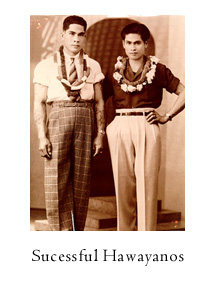Labor
Migration in Hawaii
In
contrast to the pensionados, most of the Filipino
migrants to the United States during the colonial period
came as cheap labor. During the first half of the twentieth
century, Hawaii and California had agricultural economies
requiring a constant supply of inexpensive, immigrant
labor. Hawaii’s economy focused on sugar growing
supported by plantation labor.
 To
sustain the constant demand for labor, the Hawaiian
Sugar Planters Association (HSPA) conducted a systematic,
organized recruitment of Filipino laborers. Labor recruiters
went to the Philippines and set up recruitment centers
in Vigan, Ilocos Sur,
and Cebu. In 1906 the first fifteen Filipino laborers,
all Tagalogs, came to Hawaii. Initially, the Filipinos
were averse to come to Hawaii because of the distance
and the wild rumors of alleged animals roaming the islands
and devouring the people. But recruitment campaigns
persisted and the "success" stories of the
first repatriated Filipino sugar workers or sakadas,
called "Hawayanos" in the Philippines,
eventually encouraged Filipino migration. To
sustain the constant demand for labor, the Hawaiian
Sugar Planters Association (HSPA) conducted a systematic,
organized recruitment of Filipino laborers. Labor recruiters
went to the Philippines and set up recruitment centers
in Vigan, Ilocos Sur,
and Cebu. In 1906 the first fifteen Filipino laborers,
all Tagalogs, came to Hawaii. Initially, the Filipinos
were averse to come to Hawaii because of the distance
and the wild rumors of alleged animals roaming the islands
and devouring the people. But recruitment campaigns
persisted and the "success" stories of the
first repatriated Filipino sugar workers or sakadas,
called "Hawayanos" in the Philippines,
eventually encouraged Filipino migration. The
exodus of Filipinos to Hawaii was reflected in the statistics.
In 1907, 150 Filipinos arrived in Hawaii. By 1909, 639
workers came and by 1910, there were 2,915. From 1911
to 1920, an estimated 3,000 workers arrived yearly.
In 1919, there were 24,791 Japanese workers and 10,354
Filipinos representing 54.7% and 22.9% respectively
of the total plantation labor force. The 1920s saw an
average of 7,630 Filipinos arriving in Hawaii annually.
In the 1930s, Filipinos had replaced the Japanese as
the largest ethnic group of workers in the plantations.
This was despite a temporary halt in the influx of Filipino
migrants in the early 1930s due to the Great Depression.
As a result of the Depression, a total of 7,300 sakadas
were repatriated to the Philippines.
In
1935, the Tydings-McDuffie
Law was passed. Aside from creating the Philippine
Commonwealth, a ten year transition government prior
to Philippine independence, the law also restricted
immigration to the U.S. to only fifty Filipinos each
year. The HSPA lobbied the U.S. Congress and was able
to gain exemption from the law which guaranteed a steady
Filipino labor supply until the onset of World War II.
Reasons
for Filipino Migration to Hawaii
After
the initial hesitation, Filipino migrant workers came
to Hawaii because they perceived the islands as glorya
(glory), a paradise of happiness and prosperity.
Many of them came to Hawaii for the purpose of saving
money to return home and live comfortably, i.e., to
be able to buy their own house and lot, till a small
farm, and get married. Until the 1940s most of the Filipino
sakadas believed that they were only temporary
residents of Hawaii.
Although
the initial migrants were Tagalogs, succeeding ones
were almost entirely Ilocanos. Due to the harsh living
conditions and the limited economic opportunities in
the Ilocos region, Ilocanos have been migrating to different
parts of the Philippines since the nineteenth century
to seek better fortunes. In the twentieth century, Hawaii
and California were the most appealing destinations
for adventurous Ilocanos.
Preference
for Filipino Workers in Hawaii
Hawaii
sugar planters preferred to import Filipino labor for
several reasons. First, since the HSPA paid the Filipinos
the lowest wage among the different ethnic groups in
the plantation, it was cheaper to import Filipino laborers
even if they were provided free passage to Hawaii. Second,
since the Philippines was a U.S. colony and the Filipinos
were technically U.S. nationals due to their colonial
status, from the legal standpoint it was practical to
hire Filipinos. As U.S. nationals, there were not covered
by the exclusion laws barring the importation of the
other so-called "Orientals," mainly Chinese
and Japanese. Third, Filipinos were viewed as a leverage,
an alternative labor to use against Japanese workers
who were staging strikes to improve their conditions
in the plantations. Fourth, because the Philippines
was an agrarian country exposed to sugar growing, the
HSPA felt that the Filipinos were suitable as sakadas.
But sugar was not grown in Ilocos, thus Ilocanos, who
comprised the bulk of the Filipino sakadas, were
not really exposed to the its harsh working conditions.
Fifth, the Filipinos were perceived to be docile, subservient,
and uneducated and, therefore, would not join labor
unions and be prone to strikes. Finally, the Filipinos
proved to be industrious and hardworking.
The
Filipinos who migrated to Hawaii were rural folks, many
of whom had few years of education. The HSPA preferred
to hire uneducated workers who knew nothing about their
legal rights. The migrant workers faced numerous problems
from the time they left the Philippines. While most
of them were Ilocanos, there were also a few Bisayans
or Tagalogs. Upon reaching Hawaii, they had to deal
with more ethnic diversity. Linguistic differences hampered
the workers’ ability to communicate with each other.
It was also difficult to deal with the loneliness since
they traveled without their women and family. But the
worst problem was the long hours of strenuous, back-breaking
hard work.
|

